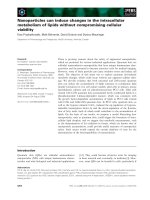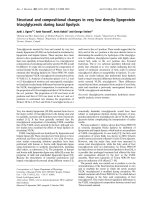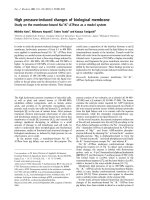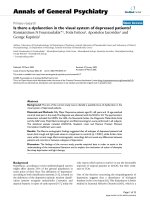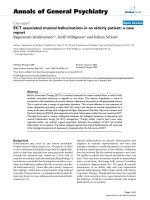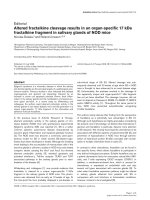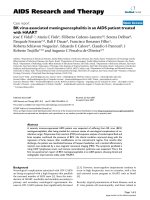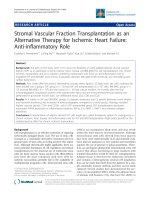Báo cáo y học: "Pulmonary vascular permeability changes in an ovine model of methicillin-resistant Staphylococcus aureus sepsis" ppsx
Bạn đang xem bản rút gọn của tài liệu. Xem và tải ngay bản đầy đủ của tài liệu tại đây (590.08 KB, 9 trang )
Open Access
Available online />Page 1 of 9
(page number not for citation purposes)
Vol 13 No 1
Research
Pulmonary vascular permeability changes in an ovine model of
methicillin-resistant Staphylococcus aureus sepsis
Collette C Jonkam
1
, Kamna Bansal
1
, Daniel L Traber
1
, Atsumori Hamahata
1
, Marc O Maybauer
1
,
Dirk M Maybauer
1
, Robert A Cox
2
, Matthias Lange
1
, Rhykka L Connelly
1
, Lillian D Traber
1
,
Clarisse D Djukom
1
, John R Salsbury
1
, David N Herndon
3
and Perenlei Enkhbaatar
1
1
Department of Anesthesiology, The University of Texas Medical Branch and Shriners Hospital for Children, 601 Harborside Drive, Galveston, TX
77555-1102, USA
2
Department of Pathology, The University of Texas Medical Branch and Shriners Hospital for Children, 301 University Blvd, Galveston, TX 77555,
USA
3
Department of Surgery, The University of Texas Medical Branch and Shriners Hospital for Children, 301 University Blvd, Galveston, TX 77555, USA
Corresponding author: Collette C Jonkam,
Received: 2 Dec 2008 Revisions requested: 12 Jan 2009 Revisions received: 3 Feb 2009 Accepted: 17 Feb 2009 Published: 17 Feb 2009
Critical Care 2009, 13:R19 (doi:10.1186/cc7720)
This article is online at: />© 2009 Jonkam et al.; licensee BioMed Central Ltd.
This is an open access article distributed under the terms of the Creative Commons Attribution License ( />),
which permits unrestricted use, distribution, and reproduction in any medium, provided the original work is properly cited.
Abstract
Introduction Endothelial dysfunction is a hallmark of sepsis,
associated with lung transvascular fluid flux and pulmonary
dysfunction in septic patients. We tested the hypothesis that
methicillin-resistant Staphylococcus aureus (MRSA) sepsis
following smoke inhalation increases pulmonary transvascular
fluid flux via excessive nitric oxide (NO) production.
Methods Ewes were chronically instrumented, and randomised
into either a control or MRSA sepsis (MRSA and smoke
inhalation) group.
Results Pulmonary function remained stable in the control
group, whereas the MRSA sepsis group developed impaired
gas exchange and significantly increased lung lymph flow,
permeability index and bloodless wet-to-dry weight-ratio (W/D
ratio). The plasma nitrate/nitrite (NOx) levels, lung inducible
nitric oxide synthases (iNOS) and endothelial nitric oxide
synthases (eNOS), vascular endothelial growth factor (VEGF)
protein expressions and poly-(ADP)-ribose (PAR) were
significantly increased by MRSA challenge.
Conclusions These results provide evidence that excessive NO
production may mediate pulmonary vascular hyperpermeability
in MRSA sepsis via up regulation of reactive radicals and VEGF.
Introduction
Despite advancements in the treatment of sepsis, its sequelae
remain associated with increased risk of death among patients
in intensive care units (ICU) [1]. From 1979 to 2000, the inci-
dence of sepsis in the USA increased by 13.7%, and the
number of sepsis-related in-hospital deaths rose from 43,579
in 1979 to 120,491 in 2000, with Gram-positive bacteria
being increasingly recognised as the most common patho-
gens (52.1% versus 37.6% Gram negative) [2]. Pneumonia is
one of the dominant causes of sepsis. Smoke inhalation injury
is frequently complicated by pneumonia [3,4]. The mortality in
fire victims increases by a maximum of 20% when associated
with smoke inhalation injury alone, by 40% with pneumonia
alone, but concomitantly they increase the mortality by up to
60% [4].
Methicillin-resistant Staphylococcus aureus (MRSA) is one of
the leading causes of nosocomial infections in burn patients
3-NT: 3-nitrotyrosine; CFU: colony forming units; CVP: central venous pressure; eNOS: endothelial nitric oxide synthase; FiO
2
: fraction of inspiratory
oxygen; H&E: haematoxylin & eosin; ICU: intensive care unit; ID: inner diameter; IL: interleukin; iNOS: inducible nitric oxide synthase; MPAP: mean
pulmonary artery pressure; MRSA: methicillin-resistant Staphylococcus aureus; NIH: National Institutes of Health; NO: nitric oxide; NOx: nitrate/nitrite;
O
2
-
: superoxide; OD: outer diameter; ONOO
-
: peroxynitrite; PaO
2
: partial arterial pressure of oxygen; PAR: poly-(ADP)-ribose; PARP: poly-(ADP)-
ribose polymerase; P
c
: pulmonary capillary pressure; PCWP: pulmonary capillary wedge pressure; PI
L
: lung permeability index; P
L
: lung lymph protein;
P
L-tot
: total lung lymph protein content; P
P
: plasma protein; π
L
: lung lymph oncotic pressure; π
P
: plasma oncotic pressure; Q
L
: lung lymph flow; Qs/
Qt: pulmonary shunt fraction; VAP: ventilator associated pneumonia; VEGF: vascular endothelial growth factor; W/D ratio: wet-to-dry-weight ratio.
Critical Care Vol 13 No 1 Jonkam et al.
Page 2 of 9
(page number not for citation purposes)
[5]. Wang and colleagues [6] reported an increased number
of patients with community-acquired MRSA bacteraemia and
showed a close association with necrotizing pneumonia. Sta-
phylococcus aureus has been reported to be a predominant
cause (38%) of ventilator-associated pneumonia (VAP) in sur-
gical ICUs [7]. MRSA-induced VAP causes a significantly
higher rate of bacteraemia and septic shock than VAP due to
methicillin-sensitive S. aureus [8].
The endothelium serves as a semi-selective barrier to solutes
and fluid. Disruption of this barrier function as seen during
inflammatory processes leads to microvascular hyperpermea-
bility [9]. In our previous study, we showed that MRSA pneu-
monia and sepsis leads to fluid accumulation and lung oedema
formation [10]. A positive fluid balance has been shown to be
an important determinant of poor outcome in patients with
lung oedema [11].
Various pathogens are known to activate different pathways in
different animal models, leading to important distinctions in the
host response [10,12]. Previously, we compared the patho-
physiological changes of sepsis induced by Pseudomonas
aeruginosa with those seen in MRSA sepsis and reported a
significantly higher fluid accumulation and plasma nitrate/
nitrite (NOx) levels in MRSA sepsis [13]. The objective of the
present study was to examine the molecular and physiological
aspects associated with pulmonary vascular permeability
changes in MRSA pneumonia and sepsis using a modified ver-
sion of our established model. This modified ovine model of
MRSA sepsis provides a clinically relevant approach for future
studies focusing on microvascular permeability changes in
MRSA-induced sepsis.
Materials and methods
The Institutional Animal Care and Use Committee of the Uni-
versity of Texas Medical Branch approved the experimental
protocol for this study. All animals were handled according to
guidelines established by the American Physiological Society
and the National Institutes of Health (NIH). The Association of
the Assessment and the Accreditation of Laboratory Animal
Care accredits the Investigational-ICU at University of Texas
Medical Branch, where the experiments were performed.
Surgical preparation
Sheep (weighing 30 to 40 kg) were surgically prepared and
chronically instrumented for haemodynamic monitoring as pre-
viously described [13,14]. Briefly, a right femoral artery cathe-
ter (18-GA, 36 inches; Parke-Davis, Sandy, UT, USA), a left
atrial catheter (0.062 inch inner diameter (ID), 0.125 inch
outer diameter (OD); Dow Corning, Midland, MI, USA) and a
Swan-Ganz thermal dilution catheter (REF 131F7; Edwards
Lifesciences LLC, Irvine, CA, USA) were placed. For the eval-
uation of pulmonary permeability, an incision was made on the
right sixth intercostal space, and the efferent lymphatic vessel
of the caudal mediastinal lymph node was cannulated with
medical-grade tubing (Silastic catheter 0.025 inches ID,
0.047 inches OD; Dow Corning, Midland, MI, USA), by a mod-
ified technique of Staub and colleagues [15], also described
by Traber and colleagues [16]. The distal end of the caudal
mediastinal lymph node was ligated and the borders of the dia-
phragm and posterior right hemithorax were cauterised to
eliminate contamination of the caudal mediastinal lymph node
by systemic afferent lymphatics.
Experimental protocol
Animals were allowed a seven-day recovery period after the
operative procedure. After collecting baseline data, sheep
were randomised to either a control group (n = 6) or a MRSA
sepsis group (n = 8). Thereafter, a tracheostomy was per-
formed under ketamine anaesthesia and a cuffed tracheos-
tomy tube (10 mm diameter; Shiley, Irvine, CA, USA) was
inserted.
Anaesthesia was continued with halothane and a Foley urinary
retention catheter (C.R. Bard, Inc., Covington, GA., USA) was
inserted in the bladder to precisely measure fluid balance. All
animals were adequately resuscitated with lactated Ringer's
solution, delivered initially at a rate of 3 mL/kg/hour and
adjusted throughout the experimental period to prevent
haemoconcentration. During the experiment, animals were
allowed free access to food but not to water in order to ade-
quately monitor fluid balance.
The MRSA sepsis animals were subjected to smoke inhalation
injury according to an established protocol [10,14,17]. Briefly,
4 sets of 12 breaths (total 48 breaths) of cotton smoke were
insufflated into the lungs using a modified bee smoker filled
with about 50 g of burning cotton toweling. After each set of
smoke inhalation, arterial carboxyhaemoglobin levels were
measured as an index of lung injury. The control animals
received 48 breaths of room air through the bee smoker.
Following smoke inhalation, 2.5 × 10
11
colony forming units
(cfu) of live MRSA (strain AW6), a bloodstream isolate [18],
was suspended in 30 mL of saline. Using a bronchoscope
(model FB-19H; Pentax, Japan), the solution was injected into
the right lower, right middle and left lower lobes. Anaesthesia
was then discontinued and animals were studied in the awake
state for 24 hours.
All sheep were mechanically ventilated (Servo 300; Siemens,
Sweden) in a volume-controlled mode with positive end-expir-
atory pressure set at 5 cmH
2
O, tidal volume maintained at 15
mL/kg and a respiratory rate of 20 breaths per minute. The
breath rate was periodically adjusted to maintain arterial car-
bon dioxide tension close to baseline values. One hundred
percent oxygen was delivered in the first three hours after
injury to accelerate the dissociation of carbon monoxide from
haemoglobin. The fraction of inspiratory oxygen was periodi-
Available online />Page 3 of 9
(page number not for citation purposes)
cally adjusted to maintain the arterial oxygen tension above 95
mmHg.
At the end of the experiment, sheep were euthanased by injec-
tion of 60 mL of saturated potassium chloride into the left
atrium under deep anaesthesia with ketamine (15 mg/kg). Tis-
sue samples were harvested, snap frozen in liquid nitrogen
and stored at -80°C for later analysis.
Measured variables
Catheters were connected to pressure transducers (REF
PXMK 1590; Edwards Lifesciences LLC, Irving, CA, USA)
with continuous flushing devices. The transducers were con-
nected to haemodynamic monitors (model IntelliVue MP50,
Philips, Boeblingen, Germany) used to measure central
venous pressure (CVP), mean pulmonary artery pressure
(MPAP), pulmonary capillary wedge pressure (PCWP), left
atrial pressure, cardiac output and mean arterial pressure as
previously described [19]. Cardiac index and pulmonary shunt
fraction (Qs/Qt) were calculated using standard formula. Pul-
monary capillary pressure (P
c
) was calculated using the for-
mula: P
c
= (0.4 × MPAP) + (0.6 × PCWP). Arterial and venous
blood gases were measured with a blood gas analyser (model
GEM Premier 3000, Instrumentation Laboratory, Lexington,
MA, USA). Lung lymph flow (Q
L
) was measured using gradu-
ated test tubes. Lung lymph protein (P
L
) and plasma protein
(P
P
) concentrations were measured using a refractometer
(National Instrument, Baltimore, MD, USA). In order to esti-
mate the pulmonary microvascular permeability to protein,
total lung protein leak per hour (P
L-tot
) was determined by mul-
tiplying the Q
L
by the P
L
. Lung lymph oncotic pressures (π
L
)
and plasma oncotic pressures (π
P
) were determined through a
semi-permeable membrane in a colloid osmometer (Model
4420; Wescor, Logan, UT, USA). Lung permeability index
(PI
L
) was calculated using the formula: (π
L
/π
P
) × Q
L
. Fluid
input and urine output were recorded every three hours and
net fluid balance was derived by subtracting output from input.
Plasma nitrate/nitrite level
Plasma nitric oxide (NO) levels were evaluated by measuring
the intermediate and end products, that is NOx, using Cayman
nitrate/nitrite colorimetric assay kit (Cayman Chemicals, Ann
Arbor, MI, USA).
Lung bloodless wet-to-dry weight ratio
The bloodless wet-to-dry weight (W/D) ratio, an index of lung
oedema, was determined using the lower half of the right lung
as previously reported [10,20].
Lung tissue immunoblotting analyses
Vascular endothelial growth factor (VEGF), lung inducible
nitric oxide synthases (iNOS) and endothelial nitric oxide syn-
thases (eNOS), 3-nitrotyrosine (3-NT) protein and PAR
expressions were measured using Western blot and quanti-
fied using NIH IMAGE J scanning densitometry [17,21].
Lung histology
Lung tissue samples were inflated with 10% formalin, embed-
ded in paraffin, sectioned into 6 μm pieces, stained with H&E
and analysed by a pathologist as previously described
[22,23].
Statistical analysis
Statistical analysis was performed using analysis of variance
and bonferroni post hoc test or unpaired t-test. Results are
presented as mean ± standard error of the mean and a p <
0.05 was considered statistically significant.
Results
All six sheep in the control group survived the entire 24-hour
experimental period, whereas only six of the eight sheep in the
MRSA sepsis group survived 24 hours. Six of the eight ani-
mals (75%) in the MRSA sepsis group had positive blood cul-
tures, indicating bacteraemia. The body temperature
increased significantly between 3 and 12 hours (Table 1), and
the white blood cell count decreased significantly in the sepsis
group compared with the controls (Figure 1). Tissues were not
harvested from the non-survivors.
There were no significant changes in cardiopulmonary func-
tion in the control animals. The injured animals developed sig-
nificantly elevated CVP, MPAP, P
c
, cardiac index and heart
rate compared with controls (Table 1). These changes were
associated with severe pulmonary dysfunction in the MRSA
Figure 1
White blood cell count in control and methicillin-resistant Staphylococ-cus aureus (MRSA) sepsis groupsWhite blood cell count in control and methicillin-resistant Staphylococ-
cus aureus (MRSA) sepsis groups. Data are expressed as mean ±
standard error of the mean. † p < 0.05 versus control.
Critical Care Vol 13 No 1 Jonkam et al.
Page 4 of 9
(page number not for citation purposes)
sepsis group, evidenced by significantly decreased partial
arterial pressure of oxygen (PaO
2
)/fraction of inspired oxygen
(FiO
2
) ratio and increased Qs/Qt (Table 1). The MRSA group
showed a significantly higher bronchial obstruction score
(20.6 ± 2.8% airway obstruction) compared with the controls
(2.5 ± 0.8%; p < 0.0001).
The Q
L
, PI
L
, P
L-tot
, lung W/D-ratio and VEGF protein expres-
sion increased significantly in the MRSA sepsis group com-
pared with the control (Figure 2 and Table 1).
These permeability changes were accompanied by signifi-
cantly increased plasma NOx levels, lung iNOS and eNOS
Table 1
Measurements at intervals after injury
Time after injury (hours)
BL 3 6 12 18 24
Body temperature (°C)
Control 39.1 ± 0.16 39.6 ± 0.19 39.5 ± 0.12 39.5 ± 0.11 39.7 ± 0.27 39.9 ± 0.17
MRSA sepsis 39.2 ± 0.11 40.9 ± 0.13† 41.0 ± 0.08† 40.3 ± 0.11† 40.1 ± 0.22 40.5 ± 0.29
CVP (mmHg)
Control 7.2 ± 0.8 10.8 ± 0.5 11.5 ± 1.1 10.2 ± 1.5 9.5 ± 0.6 8.8 ± 0.6
MRSA sepsis 5.5 ± 0.9 7.6 ± 1.4 8.0 ± 1.5 11.1 ± 1.2 16.7 ± 2.3† 14.5 ± 2.4
MPAP (mmHg)
Control 20.2 ± 0.7 25.3 ± 1.4 27.0 ± 0.9 27.0 ± 2.0 26.7 ± 1.9 25.8 ± 1.8
MRSA sepsis 19.6 ± 0.4 23.4 ± 0.7 28.4 ± 1.6 30.0 ± 1.5 34.5 ± 1.4† 32.8 ± 2.1†
Pc (mmHg)
Control 12.9 ± 0.9 17.1 ± 0.8 17.8 ± 0.5 17.4 ± 1.6 17.4 ± 1.3 16.7 ± 1.2
MRSA sepsis 12.4 ± 0.5 13.5 ± 0.6 15.8 ± 1.0 19.6 ± 0.8 23.5 ± 1.3† 22.4 ± 1.9†
P
L-tot
(mg/hour)
Control 147 ± 30 117 ± 27 147 ± 30 211 ± 65 228 ± 78 267 ± 74
MRSA sepsis 122 ± 38 539 ± 115† 728 ± 124† 636 ± 140† 610 ± 105† 611 ± 198
CI (mL/min
-1
/m
-2
)
Control 5.8 ± 0.2 5.5 ± 0.2 6.0 ± 0.8 5.3 ± 0.6 5.3 ± 0.4 4.9 ± 0.4
MRSA sepsis 6.2 ± 0.3 7.0 ± 0.4 6.7 ± 0.4 8.1 ± 0.5† 10.2 ± 0.9† 9.2 ± 0.8†
HR (bpm)
Control 94 ± 1.9 110 ± 3 116 ± 4.9 107 ± 6.2 104 ± 6.2 103 ± 5.9
MRSA sepsis 95 ± 4.1 155 ± 11.5† 162 ± 7† 167 ± 7.4† 156 ± 7.6† 142 ± 15†
PaO
2
/FiO
2
ratio
Control 509 ± 15 482 ± 35 519 ± 16 501 ± 20 532 ± 32 521 ± 12
MRSA sepsis 504 ± 7 287 ± 24† 304 ± 27† 215 ± 27† 156 ± 23† 123 ± 26†
Qs/Qt
Control 0.15 ± 0.01 0.19 ± 0.01 0.17 ± 0.02 0.2 ± 0.03 0.19 ± 0.02 0.18 ± 0.01
MRSA Sepsis 0.16 ± 0.01 0.31 ± 0.01† 0.28 ± 0.02† 0.38 ± 0.03† 0.44 ± 0.03† 0.49 ± 0.05†
All data are shown in control and methicillin-resistant Staphylococcus aureus (MRSA) sepsis groups. Data are expressed as mean ± standard
error of the mean. † p < 0.05 versus control.
BL = baseline; CI = cardiac index; CVP = central venous pressure; HR = heart rate; FiO
2
= fraction of inspiratory oxygen; MPAP = mean
pulmonary artery pressure; PaO
2
= partial arterial pressure of oxygen; Pc = pulmonary capillary pressure; P
L-tot
= total lung lymph protein; Qs/Qt =
pulmonary shunt fraction.
Available online />Page 5 of 9
(page number not for citation purposes)
Figure 2
Changes in lung permeability and VEGF measured in control and methicillin-resistant Staphylococcus aureus (MRSA) sepsis groupsChanges in lung permeability and VEGF measured in control and methicillin-resistant Staphylococcus aureus (MRSA) sepsis groups. (a) Lung
lymph flow, (b) lung permeability index, (c) lung wet/dry weight-ratio and (d) vascular endothelial growth factor (VEGF). Data are expressed as mean
± standard error of the mean. † p < 0.05 versus control.
Figure 3
Excessive nitric oxide production and PAR measured in control and methicillin-resistant Staphylococcus aureus (MRSA) sepsis groupsExcessive nitric oxide production and PAR measured in control and methicillin-resistant Staphylococcus aureus (MRSA) sepsis groups. (a) Lung
inducible nitric oxide synthase (iNOS) and (b) endothelial nitric oxide synthase (eNOS); (c) lung poly ADP ribose (PAR) and (d) plasma nitrite/nitrate
(NOx). Data are expressed as mean ± standard error of the mean. † p < 0.05 versus control.
Critical Care Vol 13 No 1 Jonkam et al.
Page 6 of 9
(page number not for citation purposes)
protein expressions in the septic animals compared with the
control group (Figure 3). Lung PAR expression, an index of
poly-ADP ribose polymerase (PARP) activity, was also signifi-
cantly increased in the septic animals compared with the con-
trol group (Figure 3). Lung 3-NT protein expression, an index
of tissue peroxynitrite (ONOO
-
) formation, showed an increas-
ing tendency after injury (control: 19032.4 ± 1207.6; MRSA
sepsis: 22264.2 ± 1097.3; p = 0.08).
The 95% confidence interval, mean difference (interpretable
as the size of the effect, if the outcome is measured on a famil-
iar scale) and p values of lung lymph flow and permeability
index, plasma NOx, lung iNOS, eNOS, PAR, VEGF and W/D
ratio are shown in Table 2.
Discussion
Sepsis caused by MRSA is most often associated with severe
outcomes. Previous studies indicate that MRSA pneumonia
and sepsis induces significantly higher plasma NOx levels and
net fluid accumulation compared with P. aeruginosa sepsis
[10,14,24]. The present study focuses on pulmonary vascular
permeability changes in MRSA sepsis. Injured animals devel-
Table 2
Confidence interval, mean difference and p values of data
Lung lymph flow 95% CI Mean difference p value
BL = 0 hours -24.77 to 23.68 -0.5458 > 0.05
3 hours -12.68 to 35.78 11.55 > 0.05
6 hours -3.977 to 44.48 20.25 > 0.05
9 hours 0.1814 to 48.64 24.41 < 0.05
12 hours 0.2981 to 48.75 24.53 < 0.05
15 hours 0.9306 to 50.85 25.89 < 0.05
18 hours 4.697 to 54.61 29.65 < 0.01
21 hours 16.22 to 68.75 42.49 < 0.001
24 hours 6.188 to 62.93 34.56 < 0.01
Permeability index-lung lymph
BL = 0 hours -10.13 to 10.09 -0.01615 > 0.05
3 hours -0.2701 to 20.64 10.19 > 0.05
6 hours 5.077 to 25.30 15.19 < 0.01
12 hours 7.769 to 27.99 17.88 < 0.001
18 hours 4.669 to 25.58 15.12 < 0.01
24 hours -5.223 to 21.15 7.964 > 0.05
Plasma NOx
BL = 0 hours -13.91 to 16.26 1.171 > 0.05
6 hours -7.868 to 16.32 4.225 > 0.05
12 hours 10.52 to 36.41 23.46 < 0.001
18 hours 7.066 to 35.57 21.32 < 0.01
24 hours 3.710 to 29.60 16.66 < 0.01
Lung iNOS 1945 to 132.6 1039 0.0296
Lung eNOS 1381 to 731.0 1056 < 0.0001
Lung PAR 3401 to 1298 2349 0.0009
Lung VEGF 1477 to 248.4 862.6 0.0119
Lung wet/dry ratio 3.846 to 0.4543 2.150 0.0176
BL = baseline; CI = confidence interval; eNOS = endothelial nitric oxide synthase; iNOS = inducible nitric oxide synthase; NOx = nitrate/nitrite;
PAR = poly-(ADP)-ribose; VEGF = vascular endothelial growth factor.
Available online />Page 7 of 9
(page number not for citation purposes)
oped hyperdynamic sepsis, evidenced by increased cardiac
index, heart rate and body temperature, decreased leucocyte
count and the presence of bacteraemia. These changes in the
MRSA sepsis group were associated with bronchial obstruc-
tion and pulmonary dysfunction. The increased Q
L
and PI
L
observed in the MRSA sepsis group signify increased pulmo-
nary transvascular fluid flux. According to the Starling equation
J
v
= K
f
((P
c
-P
i
) - ∂(π
c
- π
i
)), transvascular fluid filtration is deter-
mined by the capillary and interstitial hydrostatic (P
c
-P
i
) and
colloid osmotic pressures (π
c
-π
i
) where ∂ is the reflection coef-
ficient [25,26]. P
L-tot
increased in the sepsis group, indicating
increased permeability to protein in the pulmonary vasculature.
Previously we showed that sheep subjected to smoke inhala-
tion injury alone developed neither a decrease in plasma pro-
tein concentration and oncotic pressure nor an increase in
fluid accumulation compared with uninjured controls [10]. This
suggests that smoke inhalation injury alone does not induce
vascular hyperpermeability to protein, but rather that the
increased protein leakage is due to MRSA sepsis. The current
study showed increased P
c
consistent with the findings of
Isago and colleagues [27], that showed that increased P
c
con-
tributes to lung oedema formation after acute lung injury.
When the capacity of the lymphatic system is exceeded, fluid
tends to accumulate in the interstitial space, leading to
oedema formation. The increased lung W/D-ratio and Q
L
seen
in the sepsis group reflects this theory.
Excessive NO is implicated in many pathophysiological
changes of sepsis. Plasma NOx levels, lung iNOS and eNOS
protein expressions significantly increased after injury. This is
in agreement with other studies, which suggest that both
iNOS-derived and eNOS-derived NO plays a pivotal role in
vascular hyperpermeability during sepsis [28-30]. Although
iNOS is recognised as the dominant enzyme responsible for
the sepsis-related cardiovascular derangements, constitutive
NOS (neuronal NOS and eNOS) have also been reported to
play a major role in sepsis [31-33]. MRSA could cause severe
pulmonary vascular hyperpermeability via upregulation of both
iNOS and eNOS.
Situated in close proximity to one another, NO reacts with
superoxide (O
2
-
) to form ONOO
-
. ONOO
-
, a potent protein
nitrating species, is known to cause DNA single strand break-
age [34], vascular contractile, and endothelial dysfunction
[35,36]. Our group previously reported that the ONOO
-
decomposition catalyst WW-85 decreased lung transvascular
fluid flux in sheep with IL-2-induced increase in pulmonary vas-
cular permeability [37]. Although lung 3-NT expression was
not significantly higher in the MRSA group, we speculate that
significance may have been reached at an earlier time point,
especially because plasma NOx levels showed an early
increase followed by a decreasing tendency at 24 hours.
ONOO
-
-induced breakage of single-strand DNA triggers
excessive PARP activation that in turn causes cellular ATP
depletion, tissue damage and cell death [38,39]. Lung PAR
expression was significantly upregulated, suggesting that
excessive NO levels following MRSA sepsis could cause
increased pulmonary vascular leakage directly or through
ONOO
-
formation with subsequent PARP over activation.
The endothelium is known to play a key role in the modulation
of vascular permeability [40-42]. This study is in line with our
previous study [21], which showed that VEGF, a known potent
vascular permeability factor [43], is overexpressed in lung tis-
sue after injury, suggesting that MRSA may cause disruption
of the endothelial integrity, leading to pulmonary vascular
hyperpermeability and lung oedema. Whether NO upregulates
VEGF production or vice-versa is still controversially dis-
cussed. Kroll and colleagues [44] previously reported that the
activation of VEGF receptor-2 upregulates iNOS and eNOS
production. However, Heo and colleagues[45] have shown
that NOS inhibition using L-NAME reduced lipopolysaccha-
ride-induced NO and VEGF production in human aortic
smooth muscle cells. Furthermore, L-NAME has been reported
to inhibit iNOS-derived and eNOS-derived NO-induced VEGF
up regulation in rat colon [46], supporting the theory that
excessive NO may stimulate VEGF expression.
A limitation of this study that we would like to acknowledge is
the fact that only female sheep were used. We cannot guaran-
tee that male sheep would show exactly the same response.
However, we believe that the molecular and pathophysiologi-
cal changes in male sheep subjected to the same injury would
show the same trend as those seen in the current study. Sec-
ondly, the response seen in the lung tissue could be earlier
than would be the case in humans, because both smoke inha-
lation and bacteria were introduced directly into the lungs.
Conclusions
The current study provides evidence that the severe transvas-
cular fluid flux in the pulmonary system induced by MRSA
pneumonia and sepsis may be mediated by iNOS-generated
and eNOS-generated excessive NO via augmentation of reac-
tive nitrogen species, PARP and VEGF. We believe that this
modified MRSA pneumonia and sepsis model might provide a
clinically relevant and useful new approach for studying new
therapeutic strategies on endothelial dysfunction and its out-
come. It would be of interest to investigate the time course
(early versus late onset) of the expression of different NOS iso-
forms and VEGF after MRSA pneumonia and sepsis, and to
evaluate the role of specific NOS inhibitors on MRSA sepsis-
induced vascular hyperpermeability.
Competing interests
The authors declare that they have no competing interests.
Critical Care Vol 13 No 1 Jonkam et al.
Page 8 of 9
(page number not for citation purposes)
Authors' contributions
CCJ designed and carried out the experiments, and analysed
and interpreted the data. KB contributed in the performance,
analysis and interpretation of immunoblotting assays. DLT
contributed with grant support, study design and interpreta-
tion of the data. AH performed the complicated surgeries and
contributed in the analysis of the data. MOM and DMM drafted
the manuscript and revised it critically for important intellectual
content. RAC designed, performed and analysed the lung his-
tology data. ML collected, analysed and interpreted some of
the data. RLC designed, analysed and interpreted the immu-
noblotting assays. LDT performed the complicated surgeries.
CDD collected and analysed the data. JRS contributed in the
performance of the surgeries and the experiments. DNH con-
tributed in designing the experiment. PE contributed with grant
support, designed the experiment and interpreted the data.
CCJ, DLT, MOM, DMM and PE drafted the manuscript. All
authors read and approved the final manuscript.
Acknowledgements
This study was supported by the Shriners of North America grants
8630, 8954 and 8450. The authors thank Professor Moreillon, Univer-
sity of Lausanne, Switzerland, for the generous donation of the bacteria,
and Nettie Biondo, Jeffery Jinkins, Victoria Robinson and Edward Kraft
for expert technical assistance.
References
1. Annane D, Aegerter P, Jars-Guincestre MC, Guidet B: Current
epidemiology of septic shock: the CUB-Rea Network. Am J
Respir Crit Care Med 2003, 168:165-172.
2. Martin GS, Mannino DM, Eaton S, Moss M: The epidemiology of
sepsis in the United States from 1979 through 2000. N Engl J
Med 2003, 348:1546-1554.
3. Barrow RE, Spies M, Barrow LN, Herndon DN: Influence of
demographics and inhalation injury on burn mortality in chil-
dren. Burns 2004, 30:72-77.
4. Shirani KZ, Pruitt BA Jr, Mason AD Jr: The influence of inhalation
injury and pneumonia on burn mortality. Ann Surg 1987,
205:82-87.
5. Chim H, Tan BH, Song C: Five-year review of infections in a
burn intensive care unit: High incidence of Acinetobacter bau-
mannii in a tropical climate. Burns 2007, 33:1008-1014.
6. Wang JL, Chen SY, Wang JT, Wu GH, Chiang WC, Hsueh PR,
Chen YC, Chang SC: Comparison of both clinical features and
mortality risk associated with bacteremia due to community-
acquired methicillin-resistant Staphylococcus aureus and
methicillin-susceptible S. aureus. Clin Infect Dis 2008,
46:799-806.
7. Woske HJ, Roding T, Schulz I, Lode H: Ventilator-associated
pneumonia in a surgical intensive care unit: epidemiology, eti-
ology and comparison of three bronchoscopic methods for
microbiological specimen sampling. Crit Care 2001,
5:167-173.
8. Rello J, Torres A, Ricart M, Valles J, Gonzalez J, Artigas A, Rod-
riguez-Roisin R: Ventilator-associated pneumonia by Staphylo-
coccus aureus. Comparison of methicillin-resistant and
methicillin-sensitive episodes. Am J Respir Crit Care Med
1994, 150:1545-1549.
9. Jacobson JR, Garcia JG: Novel therapies for microvascular per-
meability in sepsis. Curr Drug Targets 2007, 8:509-514.
10. Enkhbaatar P, Joncam C, Traber L, Nakano Y, Wang J, Lange M,
Connelly R, Kulp G, Saunders F, Huda R, Cox R, Schmalstieg F,
Herndon D, Traber D: Novel ovine model of methicillin-resistant
Staphylococcus aureus-induced pneumonia and sepsis.
Shock 2008,
29:642-649.
11. Schuller D, Mitchell JP, Calandrino FS, Schuster DP: Fluid bal-
ance during pulmonary edema. Is fluid gain a marker or a
cause of poor outcome? Chest 1991, 100:1068-1075.
12. Cartwright N, McMaster SK, Sorrentino R, Paul-Clark M, Sriskan-
dan S, Ryffel B, Quesniaux VF, Evans TW, Mitchell JA: Elucidation
of toll-like receptor and adapter protein signaling in vascular
dysfunction induced by gram-positive Staphylococcus aureus
or gram-negative Escherichia coli. Shock (Augusta, Ga) 2007,
27:40-47.
13. Enkhbaatar P, Traber L, Traber D: Methicillin-resistant Staphylo-
coccus aureus-induced sepsis: role of nitric oxide. In Yearbook
of Intensive Care and Emergency Medicine Edited by: Vincent J-
L. Berlin: Springer; 2008:404-12.
14. Murakami K, Bjertnaes LJ, Schmalstieg FC, McGuire R, Cox RA,
Hawkins HK, Herndon DN, Traber LD, Traber DL: A novel animal
model of sepsis after acute lung injury in sheep. Crit Care Med
2002, 30:2083-2090.
15. Staub NC, Bland RD, Brigham KL, Demling R, Erdmann AJ 3rd,
Woolverton WC: Preparation of chronic lung lymph fistulas in
sheep. J Surg Res 1975, 19:315-320.
16. Traber DL, Adams T Jr, Henriksen N, Traber LD, Thomson PD:
Reproducibility of cardiopulmonary effects of different endo-
toxins in the same sheep. J Appl Physiol 1983, 54:1167-1171.
17. Maybauer MO, Maybauer DM, Fraser JF, Traber LD, Westphal M,
Cox RA, Huda R, Nakano YY, Enkhbaatar P, Hawkins HK, Herndon
DN, Traber DL: Ceftazidime improves hemodynamics and oxy-
genation in ovine smoke inhalation injury and septic shock.
Intensive Care Med 2007, 33:1219-1227.
18. Entenza JM, Drugeon H, Glauser MP, Moreillon P: Treatment of
experimental endocarditis due to erythromycin-susceptible or
-resistant methicillin-resistant Staphylococcus aureus with RP
59500. Antimicrob Agents Chemother 1995, 39:1419-1424.
19. Maybauer DM, Maybauer MO, Traber LD, Westphal M, Nakano
YY, Enkhbaatar P, Morita N, Herndon DN, Traber DL: Effects of
severe smoke inhalation injury and septic shock on global
hemodynamics and microvascular blood flow in sheep. Shock
2006, 26:489-495.
20. Pearce ML, Yamashita J, Beazell J: Measurement of pulmonary
edema.
Circ Res 1965, 16:482-488.
21. Lange M, Hamahata A, Enkhbaatar P, Esechie A, Connelly R,
Nakano Y, Jonkam C, Cox RA, Traber LD, Herndon DN, Traber DL:
Assessment of vascular permeability in an ovine model of
acute lung injury and pneumonia-induced Pseudomonas aer-
uginosa sepsis. Crit Care Med 2008, 36:1284-1289.
22. Cox RA, Burke AS, Soejima K, Murakami K, Katahira J, Traber LD,
Herndon DN, Schmalstieg FC, Traber DL, Hawkins HK: Airway
obstruction in sheep with burn and smoke inhalation injuries.
Am J Respir Cell Mol Biol 2003, 29:295-302.
23. Maybauer MO, Maybauer DM, Fraser JF, Traber LD, Westphal M,
Enkhbaatar P, Cox RA, Huda R, Hawkins HK, Morita N, Murakami
K, Mizutani A, Herndon DN, Traber DL: Recombinant human acti-
vated protein C improves pulmonary function in ovine acute
lung injury resulting from smoke inhalation and sepsis. Crit
Care Med 2006, 34:2432-2438.
24. Enkhbaatar P, Murakami K, Traber LD, Cox R, Parkinson JF, West-
phal M, Esechie A, Morita N, Maybauer MO, Maybauer DM, Burke
AS, Schmalstieg FC, Hawkins HK, Herndon DN, Traber DL: The
inhibition of inducible nitric oxide synthase in ovine sepsis
model. Shock 2006, 25:522-527.
25. Starling EH: On the absorption of fluids from the connective
tissue spaces. J Physiol 1896, 19:312-326.
26. Traber DL, Herndon DN, Enkhbaatar P, Maybauer MO, Maybauer
DM: The pathophysiology of inhalation injury. In Total Burn
Care 3rd edition. Edited by: Herndon DN. London, UK: Sounders
Elsevier; 2007:248-261.
Key messages
❍ MRSA sepsis causes severe vascular leakage in the pul-
monary system.
❍ Excessive NO production mediates pulmonary vascular
hyperpermeability via upregulation of VEGF, OONO
-
and PARP activity.
Available online />Page 9 of 9
(page number not for citation purposes)
27. Isago T, Noshima S, Traber LD, Herndon DN, Traber DL: Analysis
of pulmonary microvascular permeability after smoke inhala-
tion. J Appl Physiol 1991, 71:1403-1408.
28. Bucci M, Roviezzo F, Posadas I, Yu J, Parente L, Sessa WC,
Ignarro LJ, Cirino G: Endothelial nitric oxide synthase activation
is critical for vascular leakage during acute inflammation in
vivo. Proc Natl Acad Sci USA 2005, 102:904-908.
29. Hatakeyama T, Pappas PJ, Hobson RW 2nd, Boric MP, Sessa
WC, Duran WN: Endothelial nitric oxide synthase regulates
microvascular hyperpermeability in vivo. J Physiol 2006,
574:275-281.
30. Hollenberg SM, Guglielmi M, Parrillo JE: Discordance between
microvascular permeability and leukocyte dynamics in septic
inducible nitric oxide synthase deficient mice. Crit Care 2007,
11:R125.
31. Connelly L, Madhani M, Hobbs AJ: Resistance to endotoxic
shock in endothelial nitric-oxide synthase (eNOS) knock-out
mice: a pro-inflammatory role for eNOS-derived no in vivo. J
Biol Chem 2005, 280:10040-10046.
32. Enkhbaatar P, Lange M, Nakano Y, Hamahata A, Joncam C, Wang
J, Jaroch S, Traber L, Herndon D, Traber D: Role of neuronal nitric
oxide synthase in ovine sepsis model. Shock 2008.
33. Vo PA, Lad B, Tomlinson JA, Francis S, Ahluwalia A: autoregula-
tory role of endothelium-derived nitric oxide (NO) on lipopoly-
saccharide-induced vascular inducible NO synthase
expression and function. J Biol Chem 2005, 280:7236-7243.
34. Szabo C: Potential role of the peroxynitrate-poly(ADP-ribose)
synthetase pathway in a rat model of severe hemorrhagic
shock. Shock 1998, 9:341-344.
35. Cuzzocrea S, Mazzon E, Di Paola R, Esposito E, Macarthur H,
Matuschak GM, Salvemini D: A role for nitric oxide-mediated
peroxynitrite formation in a model of endotoxin-induced
shock. J Pharmacol Exp Ther 2006, 319:73-81.
36. Zingarelli B, Day BJ, Crapo JD, Salzman AL, Szabo C: The poten-
tial role of peroxynitrite in the vascular contractile and cellular
energetic failure in endotoxic shock. Br J Pharmacol 1997,
120:259-267.
37. Maybauer DM, Maybauer MO, Szabo C, Westphal M, Traber LD,
Enkhbaatar P, Murthy KG, Nakano Y, Salzman AL, Herndon DN,
Traber DL: Lung-protective effects of the metalloporphyrinic
peroxynitrite decomposition catalyst WW-85 in interleukin-2
induced toxicity. Biochem Biophys Res Commun 2008,
377:786-791.
38. Szabo C: Poly (ADP-ribose) polymerase activation and circula-
tory shock. Novartis Found Symp 2007, 280:92-103. discussion
103–107, 160–104
39. Szabo C, Dawson VL: Role of poly(ADP-ribose) synthetase in
inflammation and ischaemia-reperfusion. Trends Pharmacol
Sci 1998, 19:287-298.
40. Colgan OC, Collins NT, Ferguson G, Murphy RP, Birney YA, Cahill
PA, Cummins PM: Influence of basolateral condition on the
regulation of brain microvascular endothelial tight junction
properties and barrier function. Brain Res 2008, 1193:84-92.
41. Colgan OC, Ferguson G, Collins NT, Murphy RP, Meade G, Cahill
PA, Cummins PM: Regulation of bovine brain microvascular
endothelial tight junction assembly and barrier function by
laminar shear stress. Am J Physiol Heart Circ Physiol 2007,
292:H3190-3197.
42. Singh D, McCann KL, Imani F: MAPK and heat shock protein 27
activation are associated with respiratory syncytial virus
induction of human bronchial epithelial monolayer disruption.
Am J Physiol Lung Cell Mol Physiol 2007, 293:L436-445.
43. Brown LF, Olbricht SM, Berse B, Jackman RW, Matsueda G, Tog-
nazzi KA, Manseau EJ, Dvorak HF, Water L Van de: Overexpres-
sion of vascular permeability factor (VPF/VEGF) and its
endothelial cell receptors in delayed hypersensitivity skin
reactions. J Immunol 1995, 154:2801-2807.
44. Kroll J, Waltenberger J: VEGF-A induces expression of eNOS
and iNOS in endothelial cells via VEGF receptor-2 (KDR). Bio-
chem Biophys Res Commun 1998, 252:743-746.
45. Heo SK, Yun HJ, Noh EK, Park WH, Park SD: LPS induces
inflammatory responses in human aortic vascular smooth
muscle cells via Toll-like receptor 4 expression and nitric
oxide production. Immunol Lett 2008, 120:57-64.
46. Aoi Y, Terashima S, Ogura M, Nishio H, Kato S, Takeuchi K: Roles
of nitric oxide (NO) and NO synthases in healing of dextran
sulfate sodium-induced rat colitis. J Physiol Pharmacol 2008,
59:
315-336.
